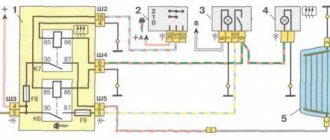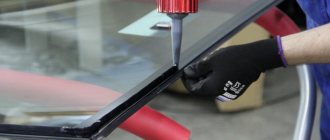To quickly remove fogging from the windshield and rear windows, conductive metal threads are applied to them. An electric current is passed through the mesh they form, the threads heat up, and the condensate evaporates. Driving with defects in this system is dangerous, visibility is reduced, and restoring the heater is quite simple in most cases.
Operating principle of heated rear window
When current passes through metals, electron energy is converted into heat. The temperature of the conductors increases in proportion to the square of the current and electrical resistance.
The cross-section of the threads is calculated in such a way as to allocate sufficient thermal power to them with a limited applied voltage. A typical value of about 12 Volts of the on-board network is used.
This is interesting: What to do if the fuel level gauge does not work
The voltage is supplied through a circuit that includes a protective fuse, a power relay and a switch that controls its winding.
A significant current flows through the relay contacts, ranging from ten amperes or more, depending on the glass area and the expected efficiency, that is, the speed of cleaning the fogged surface and the temperature of the glass and air.
The current is distributed evenly across the threads, for which they are made as accurately as possible, with a calibrated cross-section.
Danger!
Let's be clear: High resistance wire is applied primarily through paint onto glass. It is very easy to scratch or tear off, and will not work if the scratch breaks the integrity of the wire. This means that any heavy object (box, furniture) that someone placed in the car could scratch the wire. Even a credit card can rip it off. Don't pack the trunk with stuff or allow cargo to slide back in your minivan so that it touches the glass. If the glass has a defroster grill, the only thing that should touch the glass is a soft cloth dampened with glass cleaner. If you need to clean the rear window, rub gently and in the direction of the grille, not across it.
You don't need to replace the glass to make a repair. A complex rear window curve costs several thousand rubles, and a large illuminated glass on a hatchback, say, a Chevrolet Camaro, can easily add several thousand more. Add the cost of installation at the service - your insurance will definitely not cover all the costs.
Why do heating elements break?
A break can occur for mechanical or electrical reasons:
- the metal of the thread gradually oxidizes, the cross-section decreases, and the released power increases; severe overheating causes the thread to evaporate and the contact to disappear;
- when cleaning glass, a thin strip of sprayed metal can easily be damaged with the same consequences;
- even minor thermal deformations lead to a weakening of the structure of the conductive strip, which ends in the appearance of microcracks and loss of electrical contact.
Most often, one or more threads break; the entire mesh rarely fails completely. This can usually occur due to a power system failure, a blown fuse, or a failed relay or switch.
Sometimes switching is complicated by the introduction of an automatic electronic relay with timer shutdown, which does not add reliability.
Heater operation diagram
There is nothing complicated about the device. Conductive threads are installed inside the rear window or on its surface. They are supplied with voltage from the battery. The relay is responsible for continuous operation. The fuse saves the system from power surges. To start heating, just press a button. It is located under the instrument panel or on the dashboard. The maximum thread temperature is approximately 70°C.
Schematic diagram of the heating system
How to find broken glass heating filaments
Access to the conductive strips on the rear window is easy, so to troubleshoot, you can use a conventional multimeter, including an ohmmeter and a voltmeter. Both methods are suitable.
Visual inspection
In case of gross violations of the integrity, instrument monitoring may not be necessary; the break or disappearance of an entire section of the strip is noticeable to the eye. It is better to check what is found using a magnifying glass; under it, the defect is visible in all details.
When do you need a car heater through a cigarette lighter?⬆
If your car is kept in a garage, you practically never drive it during the winter season, or generally live in a mild climate, purchasing an additional interior heater is not relevant for you. Such a device is also not interesting for car owners who use a special system for automatically warming up the engine and maintaining a comfortable temperature. Such a device may also seem useless to people who do not mind wasting time warming up the car and defrosting the windows, even in the precious morning hours.
DIY rear window heating repair
Replacing heated glass will be too expensive. Meanwhile, torn strips can be repaired, for which appropriate compositions and kits are sold.
Gluing the track
For repairs using the gluing method, a special electrically conductive adhesive is used. It contains a binder and fine metal powder or fine shavings. When applied to the track, contact is restored.
It is important to preserve the linear resistance characteristics of the thread (strip). To do this, the glass is covered with masking tape, leaving a distance between the strips equal to the width of the thread being restored. The resistance of a conductor depends on its width and thickness. Therefore, all that remains is to give the repair layer the required height relative to the glass.
The necessary information on the number of application layers is determined by the density of the specific commercial adhesive and is indicated on the label. The entire repair technology is also outlined there.
After drying the last layer, the glue near the adhesive tape must be trimmed with a stationery knife so that when removing the protection, the entire sticker does not tear off the glass. The repaired area is checked visually, by the rate of condensate removal, or with an instrument using the methods indicated above.
Galvanic copper deposition
There is a method of applying a thin layer of metal to the break site using an electrochemical method. This is quite complicated, but quite accessible for electroplating enthusiasts. Reagents required are copper sulfate and a weak solution of sulfuric acid, no more than 1%.
- A galvanic brush is made. This is a bundle of multi-core wires of the smallest cross-section of individual threads. They are crimped inside a thin metal tube.
- The repair area is covered with electrical tape, leaving a gap the width of the strip. The grid is grounded to the car body, and the brush is connected to the positive terminal of the battery through a light bulb from the car's exterior lighting.
- To prepare a galvanic solution, add several grams of vitriol and battery sulfuric acid solution to 100 ml of water. Wetting the brush, move it from the beginning of the working strip to the break point, gradually depositing copper on the glass.
- After a few minutes, a copper-plated area appears, covering the break point. It is necessary to achieve approximately the same metal density as the original mesh.
If repair kits are available for sale, the method is not very relevant, but it is quite workable. The resulting conductor, after some training, will be no worse than a new one.
Troubleshooting Methods
Do-it-yourself rear window heating repair can be done in several ways to restore the filament. The choice of method depends on the width of the gap and the material of the high-resistivity thread, but the best options are the following:
- Conductive pastes and adhesives. This is a simple, inexpensive and effective method. It can be safely used if the width of the break is no more than 1 mm. There are several special kits for thread restoration on sale. Their price ranges around $12, they are sold in every auto store. The kit already includes paste, a syringe and additional cleaning accessories.
- The method of using conductive glue such as “Kontaktol” or “Elekont” will be even cheaper. In this case, it is enough to simply apply glue to the damaged area, covering the problem area by 5-10 mm. If the glue is not fake, then such a connection can work for a very long time and not cause problems.
- Method of galvanic shrinkage of copper. The method is very good, but requires a whole chemical laboratory. Doing it yourself in a garage environment can only be considered a bold experiment.
- Soft solder. An affordable and reliable method for restoring filaments. The threads are soldered using the conventional soldering method. But there is one important nuance - under no circumstances try to clean the soldering area with sandpaper. This will only lead to an increase in the width of the gap. Simply degrease the thread with acetone.
This is interesting: What are the signs that indicate the need for major repairs?
If the width of the gap is more than a millimeter, then it is worth reinforcing the thread with a 0.2 mm thick tinned copper core. For repairs, soft solder of the POS-61 brand is used. In this case, there is no need to tin the heating filament itself.
Thus, in almost 10 minutes you will solve the problem of heating the rear window and save on expensive replacement of the heater.
In what cases is it useless to repair heating elements?
If there is a significant area of damage, when almost all the threads are broken and over a large area, it is unlikely that it will be possible to restore the mesh to nominal efficiency. There is no hope for the reliability of the result. This glass must be replaced together with the heating element.
As a last resort, you can use an external heater installed under the glass, but this is a temporary measure, it works slowly, unevenly, consumes a lot of energy, and if the glass is very frozen, it can cause cracks and even spillage of tempered glass.
What causes interior glass to sweat?
Why do the windows on a VAZ 2110 fog up? This is a question that baffles half of car owners. I’ll say right away that this most likely happens in cold weather due to increased humidity in the car interior, from which I’ll now explain:
- The most common reason is if the driver has a hangover, the windows sweat from fumes
- The second most common reason is that the interior heating radiator is leaking quietly, the liquid collects under the rugs, while the leak is small, it is almost unnoticeable, so it is worth checking the condition of this radiator
- Another reason for glass fogging may be the wrong direction of the stream of warm air from the stove; if the glass is blown, it dries, when it is not blown, it may begin to “sweat”, this, by the way, is the main reason why the windshield on a VAZ 2110 sweats
Rating of anti-fog products for car windows and how to use them
There are many products available on the domestic automotive chemical market to prevent condensation formation. They are called “Anti-fog for cars”. A special composition pre-applied to the glass prevents the auto glass from fogging up in high humidity or cold weather.
ABRO
This product is of American origin. It is produced inside a 100 ml bottle, the cost of which is 190 rubles. Products under this brand are popular due to their effectiveness and practicality. The “smart” cap contains a special dispenser that allows you to use the composition most efficiently.
VERYLUBE XB
These products have proven their effectiveness in practice, and therefore have gained wide popularity among motorists. The thin protective film formed on the glass does not change the quality of the light flux at all, so after treating car windows, visibility does not deteriorate at all. The capacity of the can is 320 grams, the cost is 200 rubles.
Due to its practicality, the product is recommended for use in all Russian regions with different climates.
CarPlan
The defogger is manufactured in the UK. This composition copes well with condensation, reducing the light level by 7-9%. Sold inside a 250 millimeter bottle. The inconvenience is the lack of a cut-off valve, so there is a risk of spilling it. The cost of CarPlan is 280-300 rubles. The relatively high price can also be considered a distinct disadvantage, but the product does its job perfectly.
Lavr Anti Fog
This domestic anti-fog product perfectly prevents fogging of car windows. After application, no rainbow reflections or streaks remain on the surface. The composition includes alcohol, distilled water, surfactants, so Antifog is absolutely safe. It is recommended for use on car windows, mirrors, and motorcycle helmets. The cost of one bottle is 229 rubles.
Liqui Moly
This German anti-fog spray forms a durable protective film on glass that perfectly transmits light rays. The product is completely neutral in relation to varnish, plastic, paint, rubber. Its neutrality is the key to safety for people, animals, and the environment. The pronounced advantages here are cost-effectiveness, duration of action, and efficiency. The composition is sold inside a 250 ml can, the cost of which is 470 rubles.
Pros and cons of ceramic car fan heaters⬆
Car heaters equipped with a ceramic infrared heater have the following advantages:
- the ability to quickly heat the interior and remove frost on the windows - while the standard stove starts working only after the engine has completely warmed up, after about 15 minutes or later;
- fire safety;
- portability;
- ease of installation;
- uniform heating;
- no oxygen combustion;
- maintaining a favorable microclimate in the cabin;
- smooth power control;
- the presence of thermostats and overheating protection;
- the ability to direct the airflow in different directions;
- affordable price;
- efficiency;
- compact dimensions;
- Can be used in fan mode.
The disadvantages of using a ceramic heater include an increase in noise level and a decrease in the charge of standard electrical appliances. This disadvantage is especially noticeable with a modest engine size. Some heater models require installation with self-tapping screws, which results in minor damage to the interior surface.











